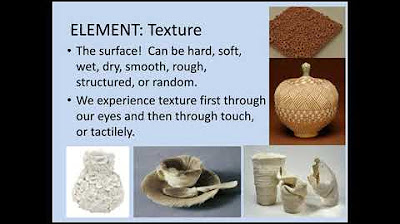Unsur-Unsur Dan Prinsip-Prinsip Seni Rupa
Summary
TLDRWelcome to the art learning video with Miss Ester! Today, we explore the elements and principles of art, including point, line, shape, form, space, texture, color, and light-dark. We'll discuss how these elements compose and apply composition principles to create aesthetically pleasing images. We'll cover various types of lines, shapes, forms, and textures, and delve into the concepts of color theory. Finally, we'll touch on the principles of composition such as balance, harmony, proportion, rhythm, dominance, and unity, providing a comprehensive foundation in the art of visual representation.
Takeaways
- 🎨 **Basic Elements of Art**: The video discusses fundamental elements of visual art, including point, line, shape, form, space, texture, color, and value (light and dark).
- 🖌️ **Point as an Element**: Points are the simplest element in visual art, used to create compositions through techniques like pointillism.
- 📏 **Lines**: Lines are arrangements of connected points and can be vertical, horizontal, diagonal, curved, zigzag, or spiral.
- 🛠️ **Shapes and Forms**: Shapes are two-dimensional forms created by lines, while forms are three-dimensional and have length, width, and height.
- 🌌 **Space**: Space is often considered an imaginary element, represented by different objects, lines, and shapes on a canvas.
- 🧶 **Texture**: Texture refers to the smoothness or roughness of a surface and is categorized into actual and implied textures.
- 🌈 **Color**: Color is the result of light reflection and can be created by pigments found in various art materials.
- 🔆 **Value (Light and Dark)**: The contrast of light and dark creates depth and clarity in artworks.
- 📐 **Principles of Art**: Principles of art include balance, harmony, proportion, rhythm, dominance, and unity.
- ⚖️ **Balance**: Balance can be symmetrical or asymmetrical, creating a sense of equilibrium in compositions.
- 🎶 **Harmony**: Harmony refers to a balanced and consistent arrangement, often achieved through similar shapes or colors.
- 📊 **Proportion**: Proportion is the relationship between parts and the whole, influencing the perception of beauty and scale in art.
Q & A
What are the basic elements of visual art discussed in the script?
-The script discusses the basic elements of visual art as point, line, shape, space, texture, color, and light and shadow.
What is a point in visual art?
-A point is the simplest element in visual art and is a technique of drawing that composes of points.
How are lines categorized in visual art?
-Lines in visual art are categorized into vertical, horizontal, diagonal, curved, zigzag, broken, and spiral lines.
What is the difference between geometric and non-geometric shapes?
-Geometric shapes have structured and regular forms, while non-geometric shapes are irregular and immeasurable.
What is space in the context of visual art?
-Space is often considered an imaginary element in visual art because its presence can only be realized with different objects, lines, and shapes on a surface like paper.
How are textures classified in visual art?
-Textures are classified into actual and implied. Actual textures are those that are seen or felt to have uniformity, while implied textures do not have uniformity when observed and touched.
What is color in visual art?
-Color in visual art is the reflection of light that appears from the selective release of certain wavelengths. It can also result from natural phenomena like the refraction of light by diamonds and rainbows.
What are the primary colors mentioned in the script?
-The primary colors mentioned are red, yellow, and blue.
How are secondary and tertiary colors formed?
-Secondary colors are formed by mixing two primary colors, such as blue mixed with yellow to make green, yellow mixed with red to make orange, and red mixed with blue to make purple. Tertiary colors are formed by mixing primary and secondary colors or by mixing three primary colors.
What are the principles of visual art composition?
-The principles of visual art composition include balance, harmony, proportion, rhythm, dominance, and unity.
What is the difference between symmetrical and asymmetrical balance?
-Symmetrical balance involves the equal distribution of objects or elements, while asymmetrical balance involves unequal distribution but still maintains balance.
How is harmony achieved in visual art?
-Harmony in visual art is achieved by arranging elements that are considered balanced and have uniformity, such as objects with similar shapes.
Outlines

此内容仅限付费用户访问。 请升级后访问。
立即升级Mindmap

此内容仅限付费用户访问。 请升级后访问。
立即升级Keywords

此内容仅限付费用户访问。 请升级后访问。
立即升级Highlights

此内容仅限付费用户访问。 请升级后访问。
立即升级Transcripts

此内容仅限付费用户访问。 请升级后访问。
立即升级浏览更多相关视频

GRADE 10 / ELEMENTS OF ARTS / ARTS 10 / QUARTER 1 / MODULE 1

Elements & Principles of Art & Design #Elements #Principles #ArtEduc #Learn #VisualArt #Artistry

The 7 Elements of Art Explained: A Fun and Easy Guide for Kids! 🎨

Unsur Unsur Seni Rupa Terlengkap [ Disertai Dengan Animasi Penjelasan ]

Mendefinisikan Fungsi, Unsur dan Ragam Karya Seni Rupa Dua Dimensi - Seni Budaya Kelas X (Fase E)

Elements and Principles 3D Art - Google Slides
5.0 / 5 (0 votes)
